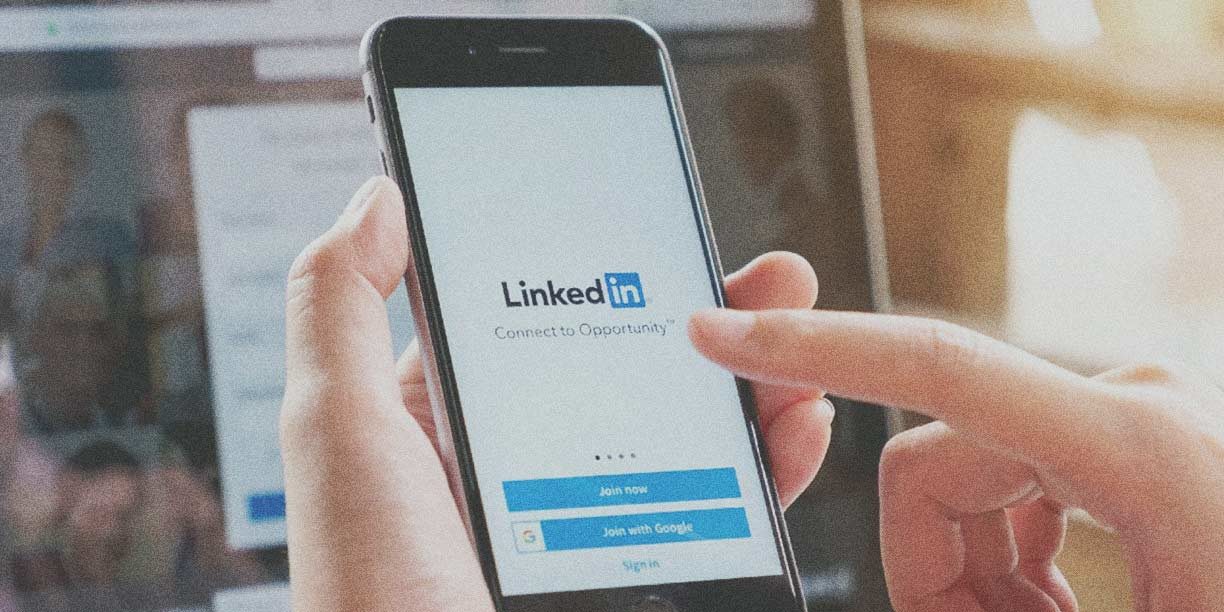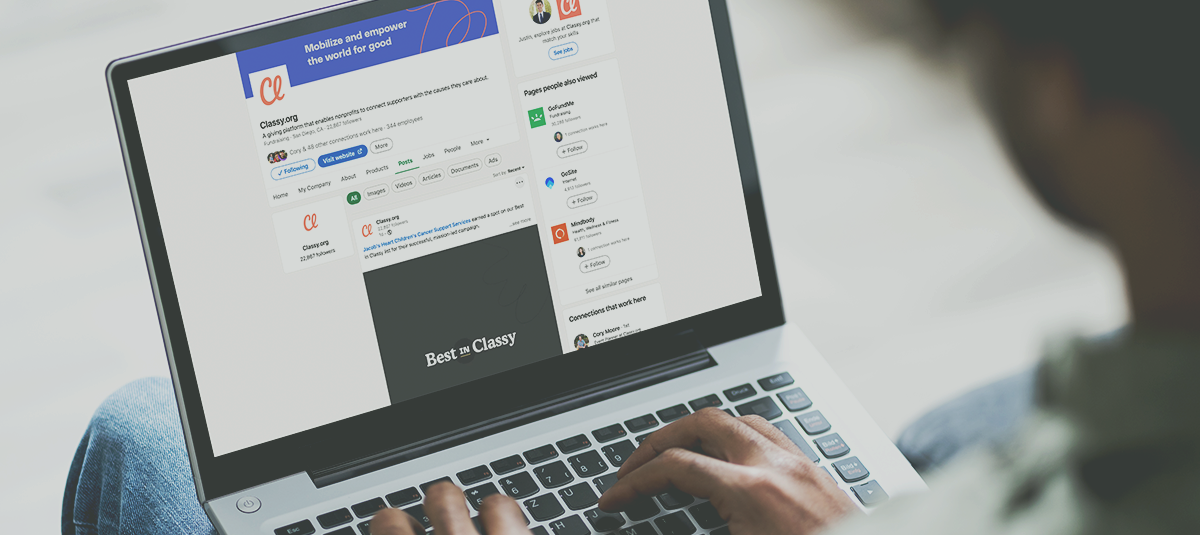LinkedIn for Nonprofits: 8 Strategies for Social Network Success

LinkedIn, like other social media platforms, has hundreds of millions of registered users. However, a large user base doesn’t guarantee engagement. A highly engaged audience, even if it’s smaller, is key to social media success.
What makes LinkedIn valuable for your nonprofit is its active audience. In fact, LinkedIn is the top choice for marketers who want to promote their content, data, and relevant news.¹
LinkedIn users are predominantly business professionals looking for connections. They’re interested in industry research, organizational best practices, and transparent storytelling, as well as opportunities to strengthen their relationships with like-minded thought leaders.
Take advantage of LinkedIn’s tremendous opportunities for organic reach by connecting with people who want to engage with you. Below, we provide eight tips to maximize your presence on LinkedIn, increase engagement with potential donors, and connect with your target audience in a more meaningful way.
LinkedIn for Nonprofits: Your Complete Checklist
How to Use LinkedIn for Nonprofits
1. Audit Other Nonprofit LinkedIn Pages
To maximize your LinkedIn presence, you need to have a point of comparison. Before you begin building or optimizing your LinkedIn page, take time to research what other nonprofits, brands, and companies do.
Identify some of the top nonprofit organizations within your cause category that operate on a similar scale. You should also examine nonprofits with an online presence that you find admirable and inspiring. For both segments, ask the following questions:
- What about the page grabs my interest?
- Is there anything here I would do differently?
- How easy is it to find relevant information about the mission, location, staff, etc.?
- What type of content does the nonprofit create?
- How many comments, likes, and shares does the content receive?
Evaluating these pages can provide insights that will shape your company page. For example, if you notice that other nonprofits within your cause category don’t prioritize video content, double down on your video marketing strategy to get ahead.
On the other hand, if nonprofits you admire write brilliant opinion pieces that generate massive engagement, consider building similar content into your strategy.
2. Optimize Your Nonprofit’s Page
The goal of auditing other pages is twofold. It provides a benchmark that shows where you stand with other nonprofits and helps identify the gaps in your page that you need to fill or update.
It’s likely that donors, volunteers, peer-to-peer fundraisers, and the general public will visit your social media pages to vet your organization further after they land on your website. And when they land on your LinkedIn page, everything needs to be clear to them, like:
- Your location
- Your number of employees
- Your organization’s mission
- Your current job openings
- Your website and fundraising campaign links
Here are three of the best Nonprofit LinkedIn profiles to inspire your process.
3. Optimize Your Page Photos
Ensure the photos on your page are high quality, sized properly, and professional. These are a direct extension of your nonprofit branding, and if your photos appear pixelated, blown out, or confusing, people are likely to lose trust and abandon your page.
For your profile image, the recommended minimum size is 400 x 400 pixels. However, you can get away with uploading a photo that’s 4320 x 7680 pixels. As long as it’s eight megabytes or less, you’re good. The best photo choice for your profile image is probably your nonprofit’s logo.
For the cover photo—the banner at the top of your page—the recommended size is 1548 x 396 pixels. This is the first thing most people will notice about your page. Instead of randomized selection, take the time to find a photo that captures the essence of your impact. You might choose a photo of:
- Your beneficiaries
- Internal staff members
- Custom-designed illustrations
- Volunteers in the field
- Event participants
4. Have Staff Update Their Profiles
As you update your nonprofit’s LinkedIn page, it’s a prime opportunity to help your staff update their LinkedIn profiles as well. This is especially critical given that their personal profiles tie directly to your nonprofit’s page when they list your organization as their employer.
As people click through to network with your employees, ensure your brand, voice, and tone carries from your page through theirs.
First, perform an audit to ensure all their headshots are business-oriented and professional. If your staff’s photos aren’t up to par, consider investing in a photographer to take professional-grade headshots of everyone.
Second, provide boilerplate copy they can use to fill in the “About” section on their profiles. In this blurb, you can include your nonprofit’s mission, the steps to accomplish it, and the associated social impact.
This helps ensure brand and voice continuity between your organization’s page and your employees’ profiles. On that note, you should also give your staff the same cover photo used on your page to provide a consistent visual.
5. Activate Your Staff
There is one piece of bad news: you can only join groups and participate in conversations as an individual, not as an organization. However, the good news is that your staff’s personal pages are now optimized and up to date. That means you can activate them to participate in conversations on your nonprofit’s behalf.
LinkedIn Groups are essentially discussion boards that provide a place to have conversations with others in your professional network. The member count ranges from the hundreds to the hundreds of thousands, and groups span just about every topic you can imagine.
Have your staff join these groups and re-promote your nonprofit’s content to tap into huge audiences of potential new donors or attendees to upcoming events.
The caveat here is that your staff can’t simply join a group and spam your content to everyone—there’s no faster way to destroy your credibility. Instead, they’ll have to participate in conversations with a vested, legitimate interest before sharing your content organically.
When done right, your content gets massive promotional legs and your staff will learn countless new social media marketing strategies and fundraising tactics to advance your organization.
6. Create Captivating Content
One of the best ways to connect with different audiences on LinkedIn is by creating relevant, interesting, and informative content. This applies to your staff as they join groups and participate in conversations, but it’s also critical for your nonprofit’s page in general.
It’s not enough to have an optimized page. You have to fill that page with resources that align with your nonprofit’s content marketing strategy.
When you publish something on your page, it gets added to the “Content” section and appears in all your followers’ feeds. If you want to drive high levels of engagement on these posts, your content needs to be compelling enough to pull in users.
Content that fits well on LinkedIn could include:
- Announcements about new hires
- Features that highlight new and existing board members
- Free resources from your nonprofit resource hub (e.g., blog posts, reports, etc.)
- Community celebrations
- Photos or videos of event volunteers
- Updates about staff working on-site with beneficiaries
- Job postings for job seekers in the nonprofit space
Content that wouldn’t fit well on LinkedIn would include:
- Links with no context
- Pixelated images
- News relating to your personal life
- Content that publishes protected or sensitive information
7. Use LinkedIn Ads
Organic posts should always be part of your LinkedIn marketing strategy. These organic updates will reach the news feeds of anyone who follows your page.
If you want to expose your nonprofit to new audiences, consider budgeting for fundraising ads.² LinkedIn offers multiple ways you can spend your budget across different types of paid ads, like:
- Message ads: Send direct messages to people that will appear in their inboxes. This works well when looking to hire for open positions.
- Sponsored content: Run video, photo, and image carousel ads in the LinkedIn feed across desktop and mobile. These ads are strong options when promoting your content.
- Text ads: Drive traffic to your nonprofit on a pay-per-click (PPC) or cost-per-impression (CPI) basis. This is the best route if you’re on a tight budget or want to target your spending.
- Dynamic ads: Create automatically personalized ads for your audience. Dynamic ads work well if you want to build brand affinity, drive traffic to your page, and increase online fundraising conversions.
8. Use LinkedIn Analytics
As you work to optimize your page, activate your staff, and promote your content, you need to know that hard work pays off. To accomplish this, make heavy use of the built-in analytics engine on LinkedIn.
Once you’re in the engine, you can break down your performance by:
- Total page views
- Number of followers
- Unique visitors to your page
- Custom button clicks
- Mobile versus desktop traffic sources
- Audience demographics
Additionally, LinkedIn will provide detailed breakdowns of every post you create. You can see the impressions, clicks, click-through rates, reactions, comments, and shares.
More than just numbers on a page, these insights are how you inform a data-driven nonprofit marketing strategy. For example, if you notice that 85% of your traffic comes from mobile sources, size most of the photos you post to your account to fit a mobile screen.
LinkedIn prioritizes professional, timely, and relevant content catered to individuals in professional fields. As your team begins to optimize your organization’s presence on LinkedIn, you can build robust strategies to supply that content to nonprofit professionals and thought leaders worldwide.
There’s also a special section on LinkedIn solely built for nonprofits—LinkedIn for Nonprofits. Take the time to explore the different ways you can leverage its tools to find top talent, drive brand awareness, and inspire action on your programs and campaigns.
Boost Donor Engagement on LinkedIn With Insights From Our New Report
Article Sources
- “The Sophisticated Marketer’s Guide to LinkedIn,” LinkedIn, last modified 2017, https://business.linkedin.com/content/dam/me/business/en-us/marketing-solutions/cx/2017/pdfs/Sophisticated-Marketers-Guide-to-LinkedIn-v03.12.pdf.
- “Get Started With LinkedIn Ads,” LinkedIn Marketing Solutions, last accessed February 13, 2023, https://business.linkedin.com/marketing-solutions/ads.

LinkedIn for Nonprofits: Your Complete Checklist



